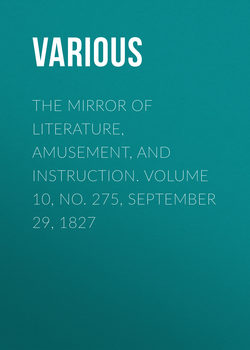Читать книгу The Mirror of Literature, Amusement, and Instruction. Volume 10, No. 275, September 29, 1827 - Various - Страница 1
KEW PALACE
ОглавлениеInnumerable are the instances of princes having sought to perpetuate their memories by the building of palaces, from the Domus Aurea, or golden house of Nero, to the comparatively puny structures of our own times. As specimens of modern magnificence and substantial comfort, the latter class of edifices may be admirable; but we are bound to acknowledge, that in boldness and splendour of design, they cannot assimilate to the labours of antiquity, much of whose stupendous character is to this day preserved in many series of interesting ruins:—
Whilst in the progress of the long decay,
Thrones sink to dust, and nations pass away.
As a record of this degeneracy, near the western corner of Kew Green stands the new palace, commenced for George III., under the direction of the late James Wyatt, Esq. The north front, the only part open to public inspection, possesses an air of solemn, sullen grandeur; but it very ill accords with the taste and science generally displayed by its nominal architect.
To quote the words of a contemporary, "this Anglo-Teutonic, castellated, gothized structure must be considered as an abortive production, at once illustrative of bad taste and defective judgment. From the small size of the windows and the diminutive proportion of its turrets, it would seem to possess
"'Windows that exclude the light,
And passages that lead to nothing.'"
Upon the unhappy seclusion of the royal architect, the works were suspended, and it now remains unfinished. Censure and abuse have, however, always been abundantly lavished on its architecture, whether it be the result of royal caprice or of professional study; but the taste of either party deserves to be taxed with its demerits.
The northern front was intended to be appropriated to the use of domestics; the whole building is rendered nearly indestructible by fire, by means of cast-iron joists and rafters, &c., certainly in this case an unnecessary precaution, since the whole pile is shortly to be pulled down. The foundation, too, is in a bog close to the Thames, and the principal object in its view is the dirty town of Brentford, on the opposite side of the river; a selection, it would seem, of family taste, for George II. is known to have often said, when riding through Brentford, "I do like this place, it's so like Yarmany."
A modern tourist, in "A Morning's Walk from London to Kew," characterizes the new palace as "the Bastile palace, from its resemblance to that building, so obnoxious to freedom and freemen. On a former occasion," says he, "I have viewed its interior, and I am at a loss to conceive the motive for preferring an external form, which rendered it impracticable to construct within it more than a series of large closets, boudoirs, and rooms like oratories." The latter part of this censure is judiciously correct; but the epithet "bastile" is perhaps too harsh for some ears.
The old palace at Kew formerly belonged to the Capel family, and by marriage became the property of Samuel Molyneux, Esq., secretary to George II. when prince of Wales. The late Frederic, prince of Wales, took a long lease of the house, which he made his frequent residence; and here, too, occasionally resided his favourite poet, James Thomson, author of "The Seasons." It is now held by his majesty on the same tenure. The house contains some good pictures, among which is a set of Canaletti's works; the celebrated picture of the Florence gallery, by Zoffany, (who resided in the neighbourhood,) was removed several years since. The pleasure-grounds, which contain 120 acres, were laid out by Sir William Chambers, one of the greatest masters of ornamental English gardening. Altogether they form a most delightful suburban retreat, and we hope to take an early opportunity of noticing them more in detail.
The old mansion opposite the palace was taken on a long lease by Queen Caroline of the descendants of Sir Richard Lovett, and has been inhabited by different branches of the royal family: and here his present majesty was educated, under the superintendance of the late Dr. Markham, archbishop of York. This house was bought, in 1761, for the late Queen Charlotte, who died here November 17, 1818.
Apart from these courtly attractions, Kew is one of the most interesting of the villages near London. On Kew Green once stood a house, the favourite retirement of Sir Peter Lely. In the church and cemetery, too, are interred Meyer, the celebrated miniature-painter, Gainsborough, and Zoffany. Their tombs are simple and unostentatious; but other and more splendid memorials are left to record their genius.
The premature fate of Kew Palace renders it at this moment an object of public curiosity; while the annexed engraving may serve to identify its site, when posterity
"Asks where the fabric stood."
THE NUPTIAL CHARM
(For the Mirror.)
There is a charm in wedded bliss.
That leaves each rapture cold to this;
There is a soft endearing spell,
That language can but faintly tell.
'Tis not the figure, form, nor face,
'Tis not the manner, air, nor grace,
'Tis not the smile nor sparkling eye,
'Tis not the winning look nor sigh.
There is a charm surpassing these,
A pleasing spell-like pleasure's breeze!
A joy that centres in the heart,
And doth its balmy sweets impart!
'Tis not the lure of beauty's power,
The skin-deep magnet of an hour;
It is—affection's mutual glow,
That does the nuptial charm bestow!
UTOPIA.
